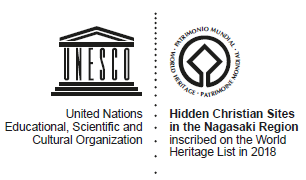History
(Ⅱ) Hidden Christians’ endeavours to continue their religious faith
Hidden Christians’ tradition to maintain their faith

 (Ⅰ) Beginning of the absence of missionaries and hiding of Christians
(Ⅱ) Hidden Christians' endeavours to continue their religious faith
(Ⅲ) Hidden Christians' endeavours to maintain their religious communities
(Ⅳ) The transitional phase triggered by contact with missionaries, leading to the end of Hidden Christians' hiding
(Ⅰ) Beginning of the absence of missionaries and hiding of Christians
(Ⅱ) Hidden Christians' endeavours to continue their religious faith
(Ⅲ) Hidden Christians' endeavours to maintain their religious communities
(Ⅳ) The transitional phase triggered by contact with missionaries, leading to the end of Hidden Christians' hiding












During the ban on Christianity, Hidden Christians in the Nagasaki region maintained village-based faith organisations (Kumi) that grew out of the religious organisations which had taken root in each village since the 16th century, and transformed their organisational structures so that they could function as the foundation for the continuation of their Christian faith. By means of these organisations, religious leaders managed to conduct rituals, teach the catechism, and follow the liturgical calendar: the Mizukata performed baptisms instead of missionaries, and the Chokata administrated the observance of the liturgical calendar.
Hidden Christians nurtured a distinctive religious system which was seemingly vernacular, while continuing rituals, ceremonies, and daily prayers. More specifically, they venerated a mountain that had been worshiped since before the introduction of Christianity to Japan as well as an island on which early Catholics had been executed in Kasuga Village and Sacred Places in Hirado. In Sakitsu Village in Amakusa, they substituted daily commodities for Christian devotional tools. In Shitsu Village in Sotome, they kept icons of the Virgin Mary and other Christian devotional items in secret, and in Ono Village in Sotome they secretly enshrined Japanese Catholics in Shinto shrines. The fact that large-scale crackdowns on Hidden Christians were no longer reported during the 18th century indicates that Hidden Christians in the Nagasaki region successfully hid their faith under their religious system and that this system was effectively passing on their faith in a relatively stable manner, compared to the past.
Furthermore, the Shogunate did not officially admit that Christians were among the people of Urakami when an incident called the Urakami Ichiban Kuzure occurred in 1790, after a century-long period of stability for Hidden Christians. The Shogunate played down the situation to prevent it from escalating into serious social disorder, which had occurred during the Kori Kuzure in the past. When the Amakusa Kuzure occurred in 1805, the Shogunate also determined that the beliefs of the people of Sakitsu were a ‘different religion’, not Christianity. These facts indicate that Japanese authorities in the 18th century had a policy of ‘tacit permission’ and that they did not punish Hidden Christians unless they disturbed the public order, even when it was found that they were present among the common people. While maintaining this delicate balance between the ‘tacit permission’ policy of the authorities and the strategy of ‘concealment and secrecy’ practised by Hidden Christians, the Hidden Christians continued their religious faith while still living within the pre-existing communities and their established religions.
Components of this stage
-

 Kasuga Village and Sacred Places in Hirado (Kasuga Village and Mt. Yasumandake)
Kasuga Village and Sacred Places in Hirado (Kasuga Village and Mt. Yasumandake)Hidden Christians concealed their faith in this village by venerating the mountain that had been worshiped since before the introduction of Christianity to Japan and the island on which their ancestors had been martyred.
-

 Kasuga Village and Sacred Places in Hirado (Nakaenoshima Island)
Kasuga Village and Sacred Places in Hirado (Nakaenoshima Island)Hidden Christians concealed their faith in this village by venerating the mountain that had been worshiped since before the introduction of Christianity to Japan and the island on which their ancestors had been martyred.
-

In Sakitsu, Hidden Christians were able to continue practising their faith over time by substituting everyday items used in daily life and work for Christian devotional objects.
-

At this village, Hidden Christians were able to practise their faith by secretly revering sacred icons.
-

In Ono Village, Hidden Christians practised their religious faith by venerating their own deities secretly enshrined in Shinto shrines.
> (Ⅰ) Beginning of the absence of missionaries and hiding of Christians
> (Ⅱ) Hidden Christians' endeavours to continue their religious faith
> (Ⅲ) Hidden Christians' endeavours to maintain their religious communities


































